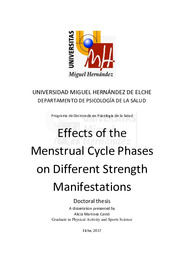Por favor, use este identificador para citar o enlazar este ítem:
https://hdl.handle.net/11000/4963Effects of the Menstrual Cycle Phases on Different Strength Manifestations
| Título : Effects of the Menstrual Cycle Phases on Different Strength Manifestations |
| Autor : Martínez Cantó, Alicia |
| Tutor: MOYA-RAMÓN, MANUEL Pastor Campos, Diego |
| Departamento: Departamentos de la UMH::Psicología de la Salud |
| Fecha de publicación: 2017-06-27 |
| URI : http://hdl.handle.net/11000/4963 |
| Resumen : The purpose of this thesis was to investigate the effect of menstrual cycle phases on strength training in both lower and upper body exercises, on dynamic and kinematic responses and on the adaptations produced after a training period using the velocity-based resistance training (VBRT). It was also to analyze the impact of the discomfort associated with menstruation on this type of training. The main findings of this thesis include: (1) different performance tests executed at maximum velocity to evaluate the power output, as well as an indirect test to evaluate the 1-RM can be performed indistinctly at any phase of the menstrual cycle; (2) the maximal velocity (Vmax) and the mean velocity during the propulsive phase (MPV) are higher in the follicular phase (in the moments prior to ovulation); (3) discomfort associated with menstruation and premenstrual syndrome adversely affect the performance test results; (4) the reported perception of effort (RPE) by the participants is greater at the time of menstruation and prior to it; (5) better results were obtained in the follicular phase in all the applied tests after two-weeks of intervention in each phase of the menstrual cycle; (6) the group reporting no discomfort associated with menstruation, obtained greater improvements in all tests in the follicular phase after two weeks of intervention, while both groups improved equally in the luteal phase. The results of this thesis indicate that the tests to evaluate strength and the power produced can be used in any phase of the cycle without affecting the results, but when a program of velocity-based resistance training is performed, it would be more productive to concentrate training loads in the first two weeks of the menstrual cycle. In addition, women who report suffering from dysmenorrhea or pain associated with menstruation, obtain worse results in the applied tests with and without an intervention program. This implies that the use of oral contraceptives can be evaluated to reduce this symptomatology and to increase the performance after analyzing if the effect of exogenous hormonal load does not affect this type of training. El propósito de esta tesis fue investigar el efecto de las fases del ciclo menstrual sobre el entrenamiento de fuerza tanto en ejercicios de tren inferior como de tren superior sobre respuestas dinámicas y cinemáticas, y las adaptaciones producidas después un periodo de entrenamiento de fuerza basado en la velocidad. También se analizó el impacto que tiene sobre este tipo de entrenamiento las molestias asociadas a la menstruación. Los principales hallazgos de esta tesis incluyen: (1) diferentes test de rendimiento ejecutados a máxima velocidad para evaluar la potencia producida y, así como un test indirecto para evaluar el 1-RM pueden ser realizados indistintamente en cualquier fase del ciclo menstrual; (2) la velocidad máxima y la velocidad media durante la fase propulsiva son mayores en la fase folicular (en los momentos previos a la ovulación); (3) las molestias asociadas a la menstruación, y el síndrome pre-menstrual afectan negativamente a los resultados de los test de rendimiento cuando se aplicaron en diferentes fases del ciclo menstrual; (4) la percepción de esfuerzo de los sujetos es mayor en los momentos de la menstruacióny previos a ella; (5) tras intervenir en cada una de las fases del ciclo menstrual, se obtuvieron mejores resultados en la fase folicular en todos los test aplicados; (6) el grupo que indicó no tener molestias asociadas a la menstruación, obtuvo mayores mejoras en todos los test en la fase folicular tras dos semanas de intervención, mientras que ambos grupos mejoraron por igual en la fase lútea. Los resultados de esta tesis indican que los test para evaluar la fuerza y la potencia pueden ser utilizados en cualquier fase del ciclo sin que el resultado se pueda ver afectado por él, pero a la hora de realizar un entrenamiento de fuerza basado en la velocidad, sería más conveniente concentrar las cargas de entrenamiento en las dos primeras semanas del ciclo menstrual. Además, las mujeres que sufren dismenorrea o dolores asociados a la menstruación, obtienen peores resultados en los test de rendimiento con o sin la aplicación de un programa de fuerza. Esto implica que se pueda valorar el uso de anticonceptivos orales para disminuir esta sintomatología y aumentar el rendimiento tras analizar si el efecto de la carga hormonal exógena no afecta a este tipo de entrenamiento. |
| Palabras clave/Materias: Fisiología del ejercicio ciclo menstrual dismenorrea entrenamiento de fuerza velocidad |
| Área de conocimiento : CDU: Filosofía y psicología: Psicología CDU: Deportes |
| Tipo de documento : info:eu-repo/semantics/doctoralThesis |
| Derechos de acceso: info:eu-repo/semantics/openAccess |
| Aparece en las colecciones: Tesis doctorales - Ciencias Sociales y Jurídicas |
 La licencia se describe como: Atribución-NonComercial-NoDerivada 4.0 Internacional.
La licencia se describe como: Atribución-NonComercial-NoDerivada 4.0 Internacional.
.png)
